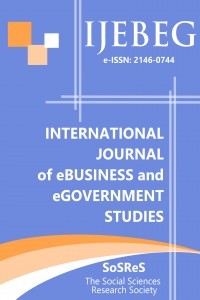ACHIEVING COMPETITIVE ADVANTAGE IN TECHNOLOGY BASED INDUSTRY: HOW DEVELOPING INTELLECTUAL CAPITAL MATTERS
ACHIEVING COMPETITIVE ADVANTAGE IN TECHNOLOGY BASED INDUSTRY: HOW DEVELOPING INTELLECTUAL CAPITAL MATTERS
___
- Barney. (1991). Firm resources and sustained competitive advantage. Journal of Management, pp.99-120.
- Bowen, D. a. (1988). Service marketing and management: implications for organizational behavior. Research in Organizational Behaviour, 10, 43–80 .
- Chen, C. J. (2009). Strategic human resource practices and innovation performance – The mediating role of knowledge management capacity. . Chen, C. J., & Huang, J. W. (2009). Strategic human resource practices and innovation performance – The mediating role of knowledgeJournal of Business Research, 62, 104–114. doi:10.1016/j.jbusres.2007.11.016.
- Coff. (1997). Human assets and management dilemmas: coping with hazards on the road to resource-based theory. Academy of Management Review, Vol. 22, No.2, 374-402.
- Coff, R. &. (2011). Drilling for Micro-Foundations of Human Capital Based Competitive Advantages. Journal of Management, 37 (5):1429-1443.
- Collins, C. J. (2003). Strategic human resource practices, top management team social networks, and firm performance: The role of human resource practices in creating organizational competitive advantage. Academy of Management Journal,, 740-751.
- Costa, L. A. (2013). The competitive implications of the deployment of unique resources. Strategic Management Journal, 34: 445–463.
- Creswell. (2012). Educational Research:Planning, Conducting, and Evaluating Quantitative and Qualitative Research. Boston: Pearson Education, Inc.
- Delery, J. E., & Roumpi, D. (2017). Strategic human resource management, human capital and competitive advantage: is the field going in circles? Human Resource Management Journal, 1748-8583.12137.
- Foss, L. P. (2011). Linking customer interaction and innovation: The mediating role of new organizational practices. Organization Science, 22, 980–999. doi:10. 1287/orsc.1100.0584.
- Hardy, C. a. (1998). The power behind empowerment: implications for research and practice. Human Relations, 51, 4, 451–83.
- Hatch, N. W. (2004). Human capital and learning as a source of sustainable competitive advantage. . Strategic Management Journal, 25: 1155-1178.
- IoannisTheotokas, M. &. (2010). Human resource management and competitive advantage: An application of resource-based view in the shipping industry. Marine Policy, 3: 575-582.
- Kinnie, J. S. (2010). Organisational learning, knowledge assets and HRpractices in professional service firms. Human Resource Management Journal, 64–79.
- Kor, Y. Y. (2005). How do interdependencies among human-capital deployment, development, and diversification strategies affect firms’ financial performance? . Strategic Management Journal, 26: 967-985.
- Lado, A. a. (1994). ‘Human resource systems and sustained competitive advantage: a competency-based perspective’. Academy of Management Review, 19: 4, 699–727.
- Lado, A. A., & Wilson, M. C. (1994). Human resource systems and sustained competitive advantage: A competency-based Perspective. The Academy of Management Review, 4: 699 -727.
- MacDuffie, J. (1995 ). Human resource bundles and manufacturing performance: organizational logic and flexible production systems in the world auto industry . Industrial and Labor Relations Review , 48: 2, 197–221.
- MacDuffie, J. P. (1995). Human Resource Bundles and Manufacturing Performance: Organizational Logic and Flexible Production Systems in the World Auto Industry. Industrial and Labor Relations Review, 2: 197- 221.
- MacMillan, R. S. (1984). Gaining competitive advantage through human resource management practices. Human Resource Management, 3: 241-255.
- Morris, S. M. (2011 ). Intellectual capital configurations and organizational capability: An empirical examination of human resource subunits in the multinational enterprise. . Journal of International Business Studies , 42, 805–827. doi:10.10.
- Nan, L. a. (2012). The Impact of Human Resource Configurations on Intellectual Capital in the Australian Biotechnology Industry. Journal of International Management Studies, Volume 7 Number 1.
- Ogden, S. G. (2006). Empowerment and Accountability: Evidence from the UK Privatized Water Industry. Journal of Management Studies, 43, 521–55.
- Ployhart RE, W. J. (2006 ). The structure and function of human capital emergence: a multilevel examination of the attraction-selection attrition model . Academy of Management Journal , 49(4): 661–677.
- Schilke, O. (2013). On the contingent value of dynamiccapabilities for competitive advantage:the nonlinear moderating effect ofenvironmental dynamism. Strategic Management Journal, 179 – 203.
- Serenko, B. &. (2009). A causal model of human capital antecedents and consequents in the financial services industry. Journal of Intellectual Capital, pp. 53-69.
- Shaw, J. D. (2005). Turnover, social capital losses, and performance . Academy of Management Journal , 48: 594-96.
- Shaw, J. D. (2013). ( A resource-based perspective on human capital losses, HRM investments, and organizational performance. . Strategic Management Journal , 34, 572– 589. doi:10.1002/smj.2025.
- Snell, S. J. (1992). Integrated Manufacturing and Human Resource Management: A Human Capital Perspective. The Academy of Management Journal, 467-504.
- Snell, Y. a. (2004). Human Resource Configurations, Intellectual Capital, and Organizational Performance. Journal of Managerial Issues, pp. 337-360.
- Soo, T. T. (2017). Intellectual capital–enhancing hr, absorptive capacity, and innovation. Human Resource Management, Vol. 56, No. 3. Pp. 431–454.
- Subramaniam, M. &. (2005). The influence of intellectual capital on the types of innovative capabilities . Academy of Management Journal , 48, 450–463. doi:10.5465/AMJ. 2005.17407911.
- Thomson, K. a. (2009). An intellectual capital perspective of human resource strategies and practices. Knowledge Management Research & Practice, 356–364.
- Weerawardena, J. (2003). The Role of Marketing Capability in Innovation-Based Competitive Strategy. Journal of Strategic Marketing, 11. 10.1080/0965254032000096766.
- Youndt, S. A. (1996). Human Resource Management, Manufacturing Strategy, and Firm Performance. The Academy of Management Journal, pp. 836-866.
- Başlangıç: 2009
- Yayıncı: Sosyal Bilimler Araştırmaları Derneği
Daniel Francois MEYER, Thomas HABANABAKİZE
E-COMMERCE IN TURKEY AND SAP INTEGRATED E-COMMERCE SYSTEM
WEBSITE USAGE IN DIGITAL PUBLIC RELATIONS – AN ANALYSIS OF IT COMPANIES IN TURKEY
AGRICULTURAL PRODUCTION IN SOUTH AFRICA: INFORMATION AND COMMUNICATION TECHNOLOGY (ICT) SPILLOVER
Oladipo Olalekan DAVİD, Wynand GROBLER
AN INVESTIGATION INTO SUSTAINABLE SUPPLY CHAIN MANAGEMENT PRACTICES IN A DEVELOPING COUNTRY
İsmail Erol, Meltem NURTANIŞ VELİOĞLU
OCCUPATIONAL HEALTH AND WORK SAFETY SYSTEMS IN COMPLIANCE WITH INDUSTRY 4.0: RESEARCH DIRECTIONS
Abdirashid Ali ADLE, Ömür AKDEMİR
A COMPARATIVE ANALYSIS OF E-GOVERNMENT SERVICES OF CROTIA, POLAND AND TURKEY
Zafer KILIÇ, Vildan ATEŞ, Aleksandar ERCEG, Sebastian JABLONSKI
